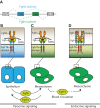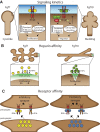Genetic insights into the mechanisms of Fgf signaling
- PMID: 27036966
- PMCID: PMC4826393
- DOI: 10.1101/gad.277137.115
Genetic insights into the mechanisms of Fgf signaling
Abstract
The fibroblast growth factor (Fgf) family of ligands and receptor tyrosine kinases is required throughout embryonic and postnatal development and also regulates multiple homeostatic functions in the adult. Aberrant Fgf signaling causes many congenital disorders and underlies multiple forms of cancer. Understanding the mechanisms that govern Fgf signaling is therefore important to appreciate many aspects of Fgf biology and disease. Here we review the mechanisms of Fgf signaling by focusing on genetic strategies that enable in vivo analysis. These studies support an important role for Erk1/2 as a mediator of Fgf signaling in many biological processes but have also provided strong evidence for additional signaling pathways in transmitting Fgf signaling in vivo.
Keywords: Erk1/2; Fgfr; fibroblast growth factor; receptor tyrosine kinase; signaling.
© 2016 Brewer et al.; Published by Cold Spring Harbor Laboratory Press.
Figures






Similar articles
-
FGF/FGFR signaling in health and disease.Signal Transduct Target Ther. 2020 Sep 2;5(1):181. doi: 10.1038/s41392-020-00222-7. Signal Transduct Target Ther. 2020. PMID: 32879300 Free PMC article. Review.
-
Targeting Drugs Against Fibroblast Growth Factor(s)-Induced Cell Signaling.Curr Drug Targets. 2021;22(2):214-240. doi: 10.2174/1389450121999201012201926. Curr Drug Targets. 2021. PMID: 33045958 Review.
-
Fibroblast growth factor signaling controlling bone formation: an update.Gene. 2012 Apr 25;498(1):1-4. doi: 10.1016/j.gene.2012.01.086. Epub 2012 Feb 9. Gene. 2012. PMID: 22342254 Review.
-
Mechanisms underlying differential responses to FGF signaling.Cytokine Growth Factor Rev. 2005 Apr;16(2):233-47. doi: 10.1016/j.cytogfr.2005.01.007. Epub 2005 Mar 5. Cytokine Growth Factor Rev. 2005. PMID: 15863038 Review.
-
FGF/FGFR signaling in bone formation: progress and perspectives.Growth Factors. 2012 Apr;30(2):117-23. doi: 10.3109/08977194.2012.656761. Epub 2012 Feb 1. Growth Factors. 2012. PMID: 22292523 Review.
Cited by
-
Elimination of endogenous high molecular weight FGF2 prevents pressure-overload-induced systolic dysfunction, linked to increased FGFR1 activity and NR1D1 expression.Cell Tissue Res. 2021 Sep;385(3):753-768. doi: 10.1007/s00441-021-03465-0. Epub 2021 May 31. Cell Tissue Res. 2021. PMID: 34057573
-
Characterisation of endogenous players in fibroblast growth factor-regulated functions of hypothalamic tanycytes and energy-balance nuclei.J Neuroendocrinol. 2019 Aug;31(8):e12750. doi: 10.1111/jne.12750. Epub 2019 Jul 8. J Neuroendocrinol. 2019. PMID: 31111569 Free PMC article.
-
Pulling back the curtain: The hidden functions of receptor tyrosine kinases in development.Curr Top Dev Biol. 2022;149:123-152. doi: 10.1016/bs.ctdb.2021.12.001. Epub 2022 Feb 28. Curr Top Dev Biol. 2022. PMID: 35606055 Free PMC article.
-
The elongation factor Elof1 is required for mammalian gastrulation.PLoS One. 2019 Jul 5;14(7):e0219410. doi: 10.1371/journal.pone.0219410. eCollection 2019. PLoS One. 2019. PMID: 31276560 Free PMC article.
-
The Emerging Role of the FGF/FGFR Pathway in Gastrointestinal Stromal Tumor.Int J Mol Sci. 2020 May 7;21(9):3313. doi: 10.3390/ijms21093313. Int J Mol Sci. 2020. PMID: 32392832 Free PMC article. Review.
References
-
- Adams RH, Porras A, Alonso G, Jones M, Vintersten K, Panelli S, Valladares A, Perez L, Klein R, Nebreda AR. 2000. Essential role of p38α MAP kinase in placental but not embryonic cardiovascular development. Mol Cell 6: 109–116. - PubMed
-
- Ahmed Z, George R, Lin CC, Suen KM, Levitt JA, Suhling K, Ladbury JE. 2010. Direct binding of Grb2 SH3 domain to FGFR2 regulates SHP2 function. Cell Signal 22: 23–33. - PubMed
Publication types
MeSH terms
Substances
Grants and funding
LinkOut - more resources
Full Text Sources
Other Literature Sources
Miscellaneous
